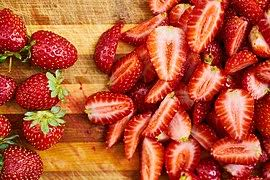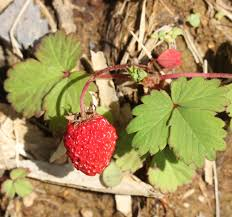Strawberry
Scientific Name: Fragaria x ananassa
Climate: Warm, moderate, and cold
Plant Description: They are herbaceous, perennial plants that grow between 10 and 20 centimeters and with roots of 25 to 40 cm. It has a central crown and creeping, noded stems emerge from there.1 The roots grow from the nodes. The leaves have three dark green folios. The flowers are white or yellow. The fruit is small and red with seeds on the outside.
Cultivation: The easiest way is to plant young plants or propagate roots instead of seeds. Make sure the roots are firmly in the soil and that the crown of the plant is level with the soil. During flowering and during the growth of the fruits it must be fertilized.
If no more plants are to be produced from the rhizomes, it is recommended to prune the roots. In early spring, clean the plants to make room for new leaves. The soil can be covered with straw to protect the plants and the fruit.
Harvest the fruits when they have a fully developed the red color and consume them as soon as possible. If harvested when the daytime temperature is high, the fruits are juicier and sweeter-tasting.
Strawberries are sown in direct sunlight. Watering should be regular and constant, especially when new leaves are growing and when the fruit is ripening to improve production. Once the fruits have formed, avoid watering the tops of the plants, especially in the evening, so that the fruit does not rot from too much direct moisture. It is preferable to water the base of the plant. It prefers clayey (muddy) and fertile soils, with good drainage.
 Uses: The edible fruit does not store well and therefore it is recommended to eat them as soon as possible after harvesting. They should be washed very well before eating. They are better raw and freshly harvested, but they can also be made into jam to preserve them longer. Strawberries are mostly water, but they are also a good source of sugar. They have little fiber, in addition to being low in calories.
Uses: The edible fruit does not store well and therefore it is recommended to eat them as soon as possible after harvesting. They should be washed very well before eating. They are better raw and freshly harvested, but they can also be made into jam to preserve them longer. Strawberries are mostly water, but they are also a good source of sugar. They have little fiber, in addition to being low in calories.
Strawberry contains potassium, magnesium, phosphorus, folic acid, vitamin A, and plenty of vitamin C, which helps the immune system stay strong and healthy. Eating strawberries can help prevent heart disease, diabetes, lower blood pressure, reduce the risk of stroke, prevent cancer, relieve constipation, and is good for pregnant women.
Pests and Diseases: Strawberries are very susceptible to pests and diseases. To avoid botrytis, mildew, and other fungal and bacterial diseases, you should keep the leaves dry and water the base of the plant with good airing. It is also important to remove dead leaves. The aphid can be controlled with garlic infusion.2
References:
- https://naturaleza.paradais-sphynx.com/plantas/tipos-de-frutas/fresa.htm
- https://www.lahuertinadetoni.es/plagas-y-enfermedades-de-la-fresa-o-frutilla/
En español: Fresa

